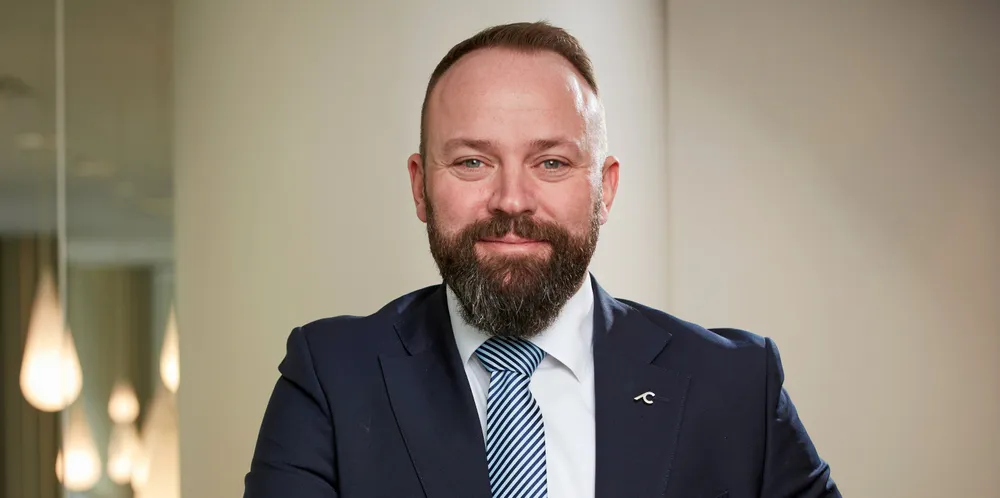Cadeler boss Mikkel Gleerup says merged vessel giant can serve 'increasingly complex' offshore wind
Soaring demand for the ships needed to install wind turbines and their foundations is spurring new moves in the sector

Cadeler chief executive Mikkel Gleerup says he is “humbled and happy” that his company will form what will be the world’s biggest wind turbine and foundation installation company following the decision to merge with Eneti, announced earlier today (Friday).
Under the $1.2bn all-share deal, two shipping giants will throw their weight behind the new entity.
BW Group-backed Cadeler and Scorpio’s Eneti, are already emerging as the top two WTIV owners outside of the Chinese market according to data from Clarksons Research, are moving decisively to consolidate.
Gleerup offered few details of how long the two listed companies have been working on the transaction but said Cadeler had reached out to Eneti about a combination.
“It’s a pretty small industry so I think it’s fair to assume we know everyone in the industry and they know us,” the CEO stated.
“We believe we have a realistic timeline in front of us and we are ready to give it all our energy,” he added.
Low on sleep
Gleerup admitted that putting a deal together was challenging: “Leading up to the process, it's always tough. I am a little bit low on sleep,” he joked.
“We are incredibly humbled and happy by the fact we are able to combine these two great track records of experience. I cannot state that clearly enough,” he added.
After three non-core ships are sold, the combined group will have 10 modern installation vessels by the end of 2026.
“We have to continue to keep a finger on the pulse of the market. We are working in an industry that grows incredibly fast,” Gleerup said.
“As a vigilant company we constantly have to ask ourselves are we right-sized for the market”.
The CEO explained that its clients can see the value in what Cadeler has done today.
“They have an increased complexity level in their projects, so it’s thumbs-up for having a stronger contractor working with them,” he said.
Shareholder backing
J Lauritzen, a Copenhagen company with stakes in both Cadeler and Eneti, is backing the merger, as as Cadeler’s other major shareholder, Swire Pacific and Eneti’s own management.
“This is a sector with high operational complexity and it is highly capital intensive, so consolidation makes very good sense for both customers and shareholders,” he added.
“So this is a deal that we welcome and we intend to remain shareholders in the merged entity,” Morch said.
Eneti, through UK subsidiary Seajacks International, has installed more than 500 wind turbine foundation components at wind farms including Akita & Noshiro in Japan, Meerwind and Veja Mate in Germany, and Moray East in Scotland.
Banks keen to lend
Cadeler believes it can achieve annual synergies of $116m per year and promises better procurement and cross-utilisation of mission equipment on the ships. The increased use of ships will mean more work can be done more quickly.
There has been no lack of appetite among banks to help the project. “We are completely bombarded with requests,” Gleerup said.
When Cadeler refinanced its X-Class vessels earlier this year, the transaction was over-subscribed by more than two times and the company has just completed a new refinancing for the fleet. “We closed that within a week,” Gleerup said.
Asked about potential future partnerships, the CEO said: “We don’t reject anything. We keep an open mind. We are obsessed with the success of our clients.”
New moves
Soaring demand for the vessels needed to install wind turbines and their foundations, and fears of a looming bottleneck, is spurring new moves in the wider sector.
In April, Eneti also teamed up with drilling giant Transocean for offshore wind farm work and is forming a joint venture with the US-listed driller to install wind turbines.
The new venture will involve the conversion of at least two Transocean drillships into floating offshore wind foundation installation platforms.
Eneti said the vessels, once converted, would be capable of carrying and installing up to six 3,500-tonne, 12-metre diameter monopile foundations with state-of-the-art safety and efficiency.
On Monday, German utility German utility RWE signed up for the exclusive use of two next-generation wind installation vessels from Jan de Nul Group, a Belgian offshore services provider.
Other leading suppliers of the larger class of WTIV, such as Hollands Van Oord, are also bringing brand new vessels to the market.